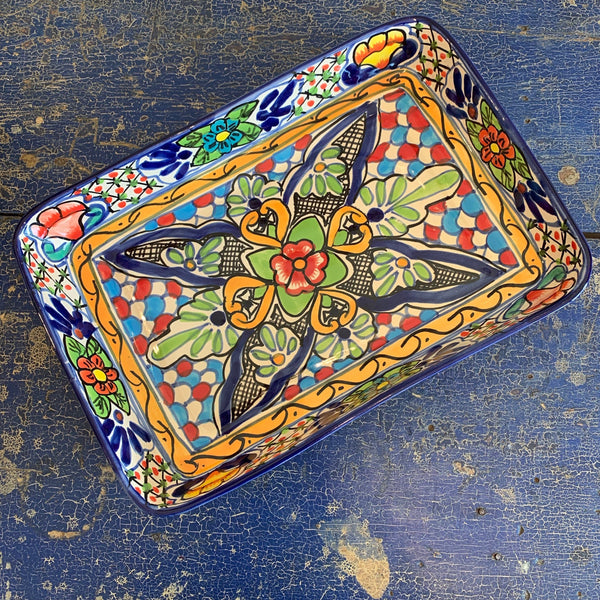For the past several months, I have had the opportunity to write some blog posts for Zinnia Folk Arts, an opportunity which has been great fun for me, both as an appreciator of Mexican craft and culture, and also as a personal blogger. As I have been writing these posts, I have had many questions for the business owner, Anne Damon, and I suspect that many Zinnia customers have wondered some of the same things. So, Anne and I decided to share the conversation we had recently, which was largely focused on how the business came to be, and also on how she keeps the product selection in the store fresh and authentic.
~Sloane LaCasse, mrsroseglasses.com
People are often surprised to see a Mexican folk art shop thriving here in the frosty northern part of the U.S. I know I wondered about that as I passed by the storefront in seasons past. I wondered how the business got started, and also how it is that Zinnia Folk Arts finds the wonderful Otomi throws, colorful huipiles, papel picado, and other bright and colorful goodies that I enjoyed seeing in that window. Writing some blog posts for the store in recent months has given me an opportunity to step into this bright and welcoming slice of Mexico, without leaving my home in Minneapolis. Recently Anne Damon, the store owner, took some time to satisfy my curiosity about the background of the store, by answering some of my questions and asking me to share what I learned.

One of the things that I wondered was how it came to be that Anne had such a love of Mexico that it would cause her to start this business, despite the lack of precedent for something like it in our local community.
As it turned out, she had an opportunity to go to Mexico to study Spanish during high school, and it was love at first sight. After that, she continued to foster her interest in Mexico and Mexican folk art while taking a long detour through a career in public health and human services, before returning to an idea that was in the back of her mind for many years—promoting the beautiful hand made traditional arts of Mexico. About 10 years ago, when it was the right time to turn that passion into a business, she recognized it and moved forward, carefully but deliberately, testing her ideas in the Twin Cities local market by starting with small pop-up shops and other temporary selling opportunities. When it was clear that there was enough demand, she opened her storefront in a cozy corner of South Minneapolis, and she has not looked back. That was five years ago. Since then, an e-commerce site has been added (www.ZinniaFolkArts.com), allowing her to share Mexican folk art treasures with customers around the world.
Since the emphasis in the folk art found at Zinnia Folk Arts is on high quality craftsmanship, I also had questions about how Anne verifies the origins of the items that she sells. Authenticity is such a market force right now, and it’s hard to know whom to trust when vendors make the claim of “handmade” or “artisan-made”. No need to worry at Zinnia, though. Anne travels to Mexico three or four times a year and maintains personal relationships with many of the artisans who make the crafts sold in her store, preferring to go where items are made, not just to where they are sold. Since many Mexican craftspeople do not have separate studios or market stalls outside of their homes, Anne frequently visits their homes and knows their families. Having been a collector of folk art for many years, her eye and familiarity with the folk arts of various regions of Mexico, helps to assure that Zinnia’s customers are getting some of the best folk arts of Mexico. A recent affirmation of this was that the Smithsonian Institution, National Museum of the American Indian, purchased several pieces for their exhibition about Day of the Dead.
Imagining her on these buying trips, I of course then wanted to know how she decides where to go; Mexico is such a large and diverse country, and Zinnia offers such a wide variety of products. I was curious if she had a method and how she planned her itinerary. She shared that most of the folk art selected for the shop is made in seven states in central and southern Mexico, where there is a greater concentration of traditional Mexican folk art.
It turns out that her method has been developed after much trial and error over the years. She routinely flies from Minneapolis to a city in central Mexico, which acts as her hub for the trip. After her arrival, she heads to different regions or markets, depending on the shop needs, coming holidays, or time of year, since particular craft items tend to be particular seasonal specialties of regions, or even specific towns. For example, when Day of the Dead is approaching, the popular Mexican holiday during which families and friends honor their deceased loved ones, she will go to regions that specialize in the folk art of that season. So on one of her recent trips, Anne made sure to get to the state of Michoacán, an excellent place to stock up on the catrinas that are so integral and representative of that holiday.
As I have learned more about Anne’s process, I also marvel at the opportunity that she has to observe the evolution of the culture and places that she visits…I wondered if she has noticed changes or trends that might not be obvious to the more infrequent visitor of Mexico. She remarked that the highs and lows in the world economy are definitely felt in Mexico, and that Americans’ fear of travel due to the drug cartels has hit Mexican artisans hard. However, in spite of economic changes Anne feels lucky that she is still able to find new and beautiful items, especially since she tends to purchase products in small quantities. And while she thinks that the fear of travel in Mexico is exaggerated, she notes that you still need to use your head and a normal amount of caution, like you would when traveling to any other unknown city or country. She recommends being friendly and not being afraid to ask for help, and also being mindful and respectful of the significant cultural differences in Mexico while traveling there. Don’t be an Ugly American!
Anne has to do a significant amount of hunting and sleuthing to secure the products for sale at Zinnia; most of the craftspeople from whom she buys products do not use email or have websites.
It has been fascinating to catch a glimpse into the store background and to understand firsthand how she can guarantee the quality of the lovely items for sale at Zinnia Folk Arts, and I am looking forward to seeing what treasures will be coming soon!
Are you interested in being on our mailing list for info about Zinnia, email-list only discounts, Mexico inspiration and shop events?

